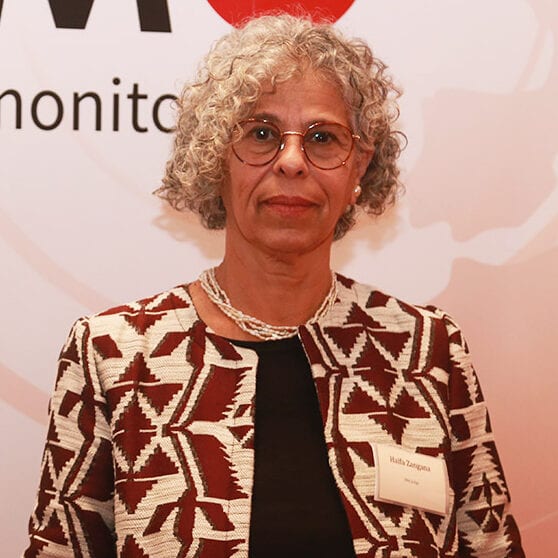On Thursday 6 August, we were preparing to commemorate the 75th anniversary of the dropping of the atomic bomb on the Japanese city of Hiroshima. But on Tuesday, we were shocked to see a similar event to that of Hiroshima take place in Beirut, mixing symbols of destruction between the past and the present and between far and nearby cities. Burning fires have been infiltrating Arab cities, in different forms, appearing and disappearing just like clouds, leaving behind body parts for the living to collect.
Beautiful Beirut has become a disaster city; a city that is claimed by everyone but taken care of by no one. How can we distinguish between disastrous cities in countries that are no longer ours? They’re full of remnants of buildings and areas that look like pictures with fraying edges and colours wiped away leaving only ash. In Iraq, Yemen, Syria and Libya, the ruins are the same and the pictures are the same, and the people can no longer distinguish the places in which they were born or the ones they built. Buildings are partially erect, without walls or windows or doors. They’ve become hollow; standing there only to defy the force of a chemical explosion, an atomic bomb, a missile, or an aerial bombardment of hundreds of tonnes. How many Hiroshimas will we have to go through?
In Syria, Hiroshima can be seen in 13 cities. The bombing in Aleppo consumed 36,000 buildings. In the city of Homs, 13,778 buildings, then Al-Raqqa with 12,781 buildings, then Hama 6,405, and Deir Ez-Zor 6,405, in addition to 5,489 in the Yarmouk camp (UNITAR on 18 March 2019). With every building, the life of a family is lost, and they are displaced in countries that add to their tragedy another ordeal of political and economic exploitation.
READ: Is there a new ‘Sykes-Picot’ race unfolding to shape Lebanon’s future?
The fatal explosion in Beirut brought Hiroshima back to the fore. The use of depleted uranium and white phosphorous in Fallujah also brought back memories of Hiroshima. Beirut became another Hiroshima, and Fallujah became Hiroshima of the “new Iraq”.
Every day we see some of Beirut’s wounded die, babies are born with birth defects in Fallujah and fathers and mothers die of cancer. What kind of congenital deformities are going to result from the explosive remnants in Beirut? American remnants are still slowly assassinating children in Fallujah. The killer is known but justice is blind.
![Lebanon is one long tale of disaster and crisis - Cartoon [Sabaaneh/MiddleEastMonitor]](https://i0.wp.com/www.middleeastmonitor.com/wp-content/uploads/2020/08/IMG_1180.jpeg?resize=933%2C583&ssl=1)
Lebanon is one long tale of disaster and crisis – Cartoon [Sabaaneh/MiddleEastMonitor]
The fatal explosion in Beirut reduced time between far-flung cities: Hiroshima – Fallujah – Beirut. There is symbolism of horror in the way of death: either fast, as in the bombing and demolition of homes on the heads of their inhabitants, burying them under the rubble, or slow, extending over decades, as is the case in chemicals and depleted uranium. And what’s heart-breaking is that “the rate of cancer cases and birth defects in Fallujah, which was subjected to US bombing in 2004, is greater than the rate in the Japanese cities of Hiroshima and Nagasaki, which were hit by atomic bombs in World War II.”
In less than a moment, death and destruction devoured everything. We can still hear the screams of those who died. In Mosul, Airwars, which tracks and archives air warfare in the Middle East, documented the attacks in Iraq and Syria, describing the number of victims of the American air strikes in Iraq “as the highest since the Vietnam War, yet the Western and Iraqi governments show no interest in documenting the numbers of victims.”
The Politics of War: What is Israel’s Endgame in Lebanon and Syria?
To bomb Mosul, America used the B-52 bomber, which was modernised with missiles and laser-guided bombs, F-16s and F-A-18s, Reaper drones, as well as Apache bomber helicopters. It is true that the terrorist group ISIS Daesh mines, many of which are still buried under the rubble, but the coalition forces threw bombs weighing 500 pounds each, penetrating the ground for a distance of 15 metres or more, according to the director of the United Nations Mine Action Program.
What does the future hold for Beirut, which has embraced us all with all our struggles, dilemmas, seminars, books, aspirations and the dreams of our youth? What does it hold for our countries that are plagued by tyranny, corruption and sectarianism? Will the visit of French President Macron heal Beirut’s wounds and restore its glory and self-esteem? When did the colonial countries turn into humanitarian organisations, or are they really humanitarian in comparison with the local corrupt rulers? Did the visit of US President Trump heal the bleeding wounds of Iraq? How would it do so while he awards medals to Iraqi killers and blesses the rulers of corruption? Have we reached an era in which we, as peoples who have seen the worst from their rulers, have come to beg for a return to the bosom of liberators who, for centuries, have marked us with human inferiority? Will we be the last ones standing? Or will we leave just like the Japanese atomic bomb poet Sankichi Toge, from Hiroshima, and chant like he did: “Little children, do not be silent, speak up, resist the adults in the whole world, warlords, shout at them, with bright voices, eyes that shine, open your arms, release them to embrace everyone, give everyone a hug, restore good tears to hearts, and sing to them, ‘We are the children of Hiroshima’.”
This article first appeared in Arabic in Al-Quds Al-Arabi on 10 August 2020
The views expressed in this article belong to the author and do not necessarily reflect the editorial policy of Middle East Monitor.


![An aerial view shows the massive damage done to Beirut port's grain silos and the area around it on 5 August 2020 [AFP via Getty Images]](https://i0.wp.com/www.middleeastmonitor.com/wp-content/uploads/2020/08/GettyImages-1227918091.jpg?fit=1200%2C800&ssl=1)









